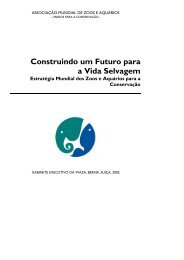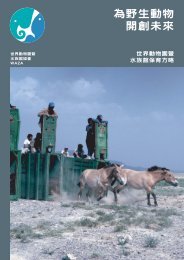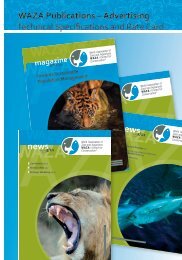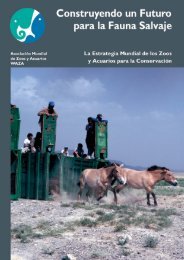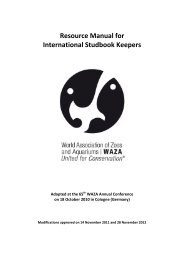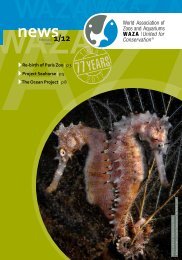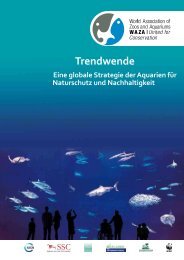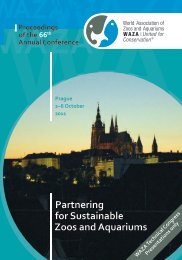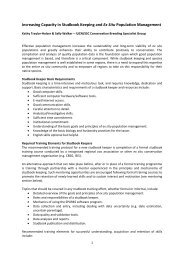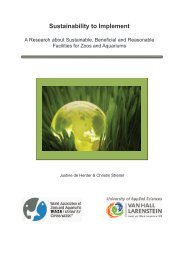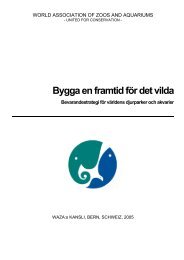Towards Sustainable Population Management - Waza
Towards Sustainable Population Management - Waza
Towards Sustainable Population Management - Waza
You also want an ePaper? Increase the reach of your titles
YUMPU automatically turns print PDFs into web optimized ePapers that Google loves.
WAZA magazine Vol 12/2011<br />
Fig. 3<br />
Species richness map for threatened mammals, birds and amphibians within ISIS zoos<br />
(top) and in their natural ranges (bottom; modified from Grenyer et al. 2006).<br />
Zoo species richness is represented by points coloured to indicate the number<br />
of species within individual zoos; global species richness corresponds to<br />
the number of species occurring within a 1° latitude by 1° longitude cell.<br />
Reptiles are omitted because the IUCN Red List assessment is still<br />
incomplete (modified from Conde et al. 2011a).<br />
success of their reintroductions into<br />
the wild (Pelletier et al. 2009). In this<br />
sense, studbook keepers have an<br />
important responsibility and a key<br />
role to play since the data they collect<br />
cannot only be helpful for the<br />
management of the species in their<br />
institutions but also for the development<br />
of conservation and management<br />
programmes, such as the<br />
reintroduction of threatened species<br />
into the wild.<br />
The implementation of cooperative<br />
captive breeding programmes across<br />
large numbers of institutions, which<br />
are also referred as Intensively Managed<br />
<strong>Population</strong>s (IMPs), is one of the<br />
more demanding actions where zoos<br />
as a global network could play a key<br />
role. There are many challenges that<br />
must be overcome in order to further<br />
develop these programmes. For<br />
example, one of the first issues will be<br />
to identify which species will need the<br />
assistance of captive breeding before<br />
it is too late to successfully implement<br />
it. The Conservation Breeding<br />
Specialist Group (CBSG) of the IUCN<br />
Species Survival Commission (SSC)<br />
is currently working on guidelines to<br />
identifying those species. Another<br />
challenge is to estimate the capacity<br />
of zoos, both in terms of space and<br />
monetary funds, to manage sustainable<br />
IMPs that could be reintroduced<br />
into the wild over the long term. For<br />
this reason, accurate data on at-risk<br />
species will be essential for the prioritisation<br />
and management of IMPs. In<br />
the future, organisations such as ISIS<br />
will certainly play an active role in<br />
providing critical information support<br />
for IMP programmes among member<br />
zoos across the world; therefore,<br />
there is a need for more institutions<br />
to become part of this global network,<br />
in particular for zoos in countries that<br />
are located in areas with high biodiversity<br />
and high threat, but which are<br />
under-represented in ISIS. Zoos are at<br />
the forefront of global conservation<br />
efforts and, with their combined efforts,<br />
their network has the potential<br />
to make a huge difference.<br />
References<br />
Threatened Species 29<br />
• Conde, D. A., Flesness, N., Colchero,<br />
F., Jones, O. R. & Scheuerlein,<br />
A. (2011a) An emerging role<br />
of zoos to conserve biodiversity.<br />
Science 331: 1390–1391.<br />
• Conde, D. A., Flesness, N., Colchero,<br />
F., Jones, O. R. & Scheuerlein,<br />
A. (2011b) Zoos and Captive<br />
Breeding – Response. Science<br />
332: 1150–1151.<br />
• Conway, W. G. (2011) Buying<br />
time for wild animals with zoos.<br />
Zoo Biology 30: 1–8.<br />
• Grenyer, R., Orme, C. D. L., Jackson,<br />
S. F., Thomas, G. H., Davies,<br />
R. G. et al. (2006) Global distribution<br />
and conservation of rare and<br />
threatened vertebrates. Nature<br />
444: 93–96.<br />
• Gusset, M. & Dick, G. (2011)<br />
The global reach of zoos and<br />
aquariums in visitor numbers and<br />
conservation expenditures. Zoo<br />
Biology 30: in press.<br />
• Hoffmann, M., Hilton-Taylor, C.,<br />
Angulo, A., Böhm, M., Brooks,<br />
T. M. et al. (2010) The impact of<br />
conservation on the status of the<br />
world’s vertebrates. Science 330:<br />
1503–1509.<br />
• Pelletier, F., Réale, D., Watters, J.,<br />
Boakes, E. H. & Garant, D. (2009)<br />
Value of captive populations for<br />
quantitative genetics research.<br />
Trends in Ecology and Evolution<br />
24: 263–270.



